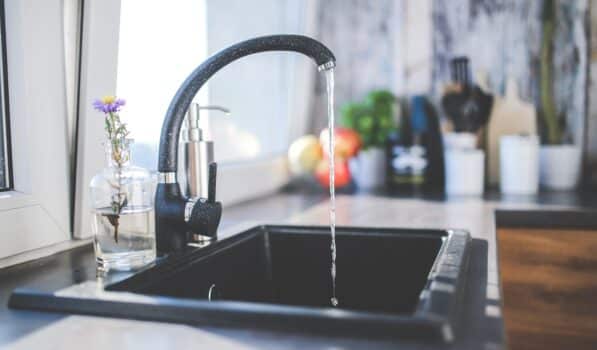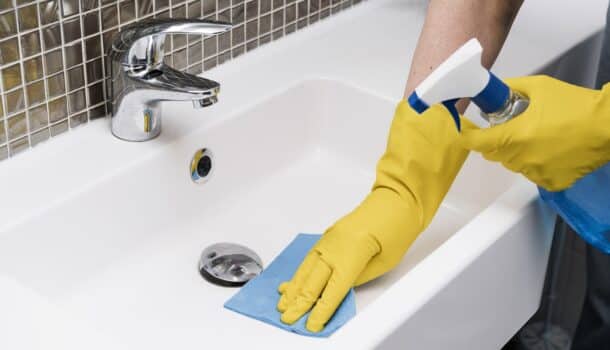The kitchen is one of the essential areas in any house. And a black acrylic sink can work wonders to improve its appearance and appeal.
Not only does a black acrylic sink look great, it also doesn’t suffer from the usual wear-and-tear that sinks made of metal or porcelain start showing after a while. This only serves to enhance its attraction. However, as always, there’s a catch!
The trouble is that acrylic sinks can easily collect dirt and grime, and lose their characteristic sheen. Plus, they also attract stains and scratches much more frequently. All this necessitates the regular cleaning of these types of sinks.
Today, we are going to discuss how you can clean black acrylic sinks easily using materials that are usually found around the house. Just for the sake of convenience, we are going to discuss multiple methods so you can select the one best suited for your needs.
Without further ado, let’s get going.
Methods to Clean a Black Acrylic Sink

Cleaning a black acrylic sink is easier than it sounds. The task can be completed using items that are readily available at home, though more potent chemical agents may also be needed in specific cases.
The following are some of the many methods that can be used to clean a black acrylic sink. Each method is equally effective, and you can select the one most convenient for you. In each case, remember to rinse the sink using water before proceeding.
Using Vinegar-and-Water Spray
This is one of the simplest methods you can use, and all the ingredients needed are usually available at home. All you need is white vinegar, hot water, and a dash of essential oils if you feel the need.
First, you need to take an empty spray bottle, and mix hot water and vinegar in a 2:1 ratio. Here, the ratio is important, as vinegar is acidic and high concentrations might damage the sink. So, twice as much water is used to dilute it.
During this step, you might want to add a bit of essential oil to the mix. This won’t affect the level of cleaning but will lend the entire area a pleasant aroma.
Next, wipe the sink with a dry piece of cloth or a towel, and spray the entire sink with the mixture of water and vinegar. Make sure you cover all nooks and crannies of the sink, as this will ensure thorough cleaning. Allow it to work its magic for a few minutes.
Finally, take a wet sponge and wipe off the mixture. In case you find tough stains, you might have to rub them off using a dry rag. Rub off the mixture thoroughly, and you’ll have a sink that’s as good as new.
The most significant advantage of using vinegar with hot water is that it forms a potent yet mild concoction that cleans dirt and grime but doesn’t damage the sink. Plus, vinegar is non-toxic, so you don’t have to worry about harmful sink residues.
Using Diluted Bleach
As anyone who has worked in the kitchen knows full well, bleach is an excellent material for all forms of kitchen cleaning. It’s safe, quickly removes dirt and stains, and also makes short work of harmful microorganisms.
At this point, you might be wondering whether your sink will lose color due to using bleach. While it’s true that bleach removes dye colors, acrylic sinks are pigmented during the molding process. So, there’s no risk of losing the color.
Before starting the entire process, make sure that the room is airy, and open any windows that might be closed. Then, fill the sink with hot water and pour in the bleach; take care to maintain a 1:10 ratio of bleach to the water.
Next, leave the mixture in the sink for anywhere from 15 minutes to an hour. Naturally, the longer you leave the mixture, the greater the cleaning level you’ll obtain. During this step, take care and notice if any pungent gases are coming from the combination.
Once you’re sure that the sink has been cleaned enough, unstopper the sink and allow the mixture to drain. And yes, do remember to wear gloves during the entire operation and make sure the mixture doesn’t get onto your bare skin.
After the last step, your sink should be as good as new. Finally, take a wet sponge and rinse the entire sink with water to remove any residue.
An important word of caution here: never use vinegar with bleach as combining the two can lead to the release of chlorine gas, which is lethal. So, if you notice any pungent smell, stop the process immediately and head for open air.
Using Rubbing Alcohol
In case you don’t want to handle potentially hazardous materials such as bleach, then rubbing alcohol (chemically called isopropyl alcohol) can provide a viable alternative. Cost-effective and efficient, the alcohol cleans the sink and destroys any harmful microorganisms in the process.
For cleaning the sink using this method, all you need is hot water, some rubbing alcohol, and a dry sponge. First, wet the sponge with water and pour some rubbing alcohol onto it. Be sure to use a soft sponge, as otherwise, you might end up scratching your sink.
Next, in fast and vigorous moves, begin cleaning the sink surface. Make sure you cover every corner and soak the sponge in alcohol again if needed. Also, be sure you’re rubbing hard enough to remove tough stains.
Since rubbing alcohol dries up very fast, you don’t need to wait for the sink to dry. Nevertheless, using this method can leave a strong smell in the sink, so take a wet rag and rinse the entire area. Then dry with a towel if needed.
Note: you can also perform the same procedure with dishwashing liquid. Just take a few drops of the liquid on a wet sponge and scrub off any stubborn stains. Dry with a rag or towel afterward.
Common Precautions to Take While Cleaning Acrylic Sinks
While you can use any of the above methods for making your kitchen sparkly clean, there are some precautions that must be taken. This is essential to ensure your safety, not to mention the well being of the sink itself.
First, always remember to wear gloves and protective goggles while cleaning the kitchen sink. This will ensure that any harmful chemicals or cleaning agents don’t get on your skin, or find their way into your eyes.
Also, cleaning agents can often mix to give off harmful gases (for example, chlorine). To avoid the build-up of such gases, open all windows, and remember to turn on the exhaust system before beginning the cleaning operation.
Another factor to keep in mind is the sponge or cloth you’re using to clean the sink. Acrylic sinks get scratched easily, and this might lead to long term damage. So, always use a soft sponge or cloth to clean the sink, and never resort to abrasive materials such as steel wool.
When using vinegar or chlorine bleach for cleaning the sink, please remember not to let the cleaning agent sit in the sink for too long. These agents are corrosive by nature and might damage the sink if allowed to settle.
Finally, take care to wipe your sink clean with a dry cloth after every use. Without daily maintenance, the sink is bound to get dirty fast. Then, instead of a quick wipe, you’ll have a big cleaning chore on your hands.

Final Words
A black acrylic sink is more than just a kitchen accessory; it’s an undeniable style statement that refuses to be ignored. No matter what you’re cooking, guests, friends, and family will enjoy the sight of a clean sink in the kitchen.
By following the methods and guidelines we discussed today, you can ensure that your kitchen sink remains spotlessly clean. Just make sure to care for the sink daily and give it a complete cleanup periodically, and you’ll be good to go.
And yes, don’t forget to take the required safety precautions before proceeding with the cleanup operation. This is vital for your health and safety, as well as of those around you.
With that piece of advice, we’ll leave you to the task at hand. Till next time!
Related Articles
9 Best Copper Sinks for Legendary Designs
7 Best Sink Protectors Reviewed
13 Best Double Bowl Kitchen Sinks
13 Best Kitchen Sink Faucets to Consider | Buyer’s Guide + Reviews
How to Repaint a Fireclay Farmhouse Kitchen Sink
10 Best Undermount Bathroom Sinks
How to Wash Dishes in a Farmhouse Sink


